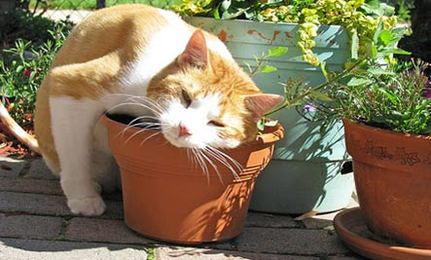There is no doubt that catnip prompted the Cheshire Cat’s grin. Our cat Ping wears the same expression when she indulges. But why do cats find this nondescript herb so attractive? Is it a kitty aphrodisiac, a harmless pleasure or something more sinister?
Nepeta cataria, or catnip, is a strong-scented mint that contains a volatile oil that is easily released into the air. Biting or rolling on the plant crushes the leaves and releases the oil so cats can get a good sniff. It does not take much. Cats can detect catnip oil in the air at saturations as low as one part per billion.
How Catnip Works
Rather than a simple smell, the chemical in catnip resembles sedative components also found in the valerian plant, which may be used in natural therapies to calm pets and people. Catnip also may be similar to one of the substances found in tomcat urine-yucky to you, but a lovely smell to the cat! In fact, this pheromone in urine often triggers the same sort of behavioural reaction in cats as exposure to catnip.
These types of chemicals, once inhaled, enter the cat’s highly specialized scenting organ through the roof of the mouth. The vomeronasal or Jacobson’s organs sit between the hard palate of the mouth and the septum of the nose, and connect to the mouth via tiny conduits directly behind the cat’s upper incisor teeth. You may see your cat perform an odd facial grimace with lips curled back and mouth open when employing this organ.
The Jacobson’s organs are linked to the hypothalamus, an area of the brain that acts like a switchboard to direct information to higher centres. This part of the brain integrates taste and smell, motivates appetite, and triggers a variety of behaviours.
Catnip in cats affects the same biochemical pathways that are affected by marijuana and LSD in people. In its simplest terms, catnip is a feline hallucinogen. The “high” lasts from five to 15 minutes, and causes a loss of inhibition. Catnip-intoxicated cats act like furry fools who roll and flop about on the floor, drool, and have a wonderful relaxing time.
Which Cats Are Affected
Cats rarely respond to catnip until they are about six months old, and some cats never do. The trait is an inherited one, with only two out of three domestic cats being affected. Boy cats seem to respond more strongly than females.
Since catnip belongs in the mint family, cats often react in a similar way to other types of mint. We have witnessed cats reacting to a type of honeysuckle – or even olives.
Most scientists agree that catnip provides a harmless recreation for cats. For cats who respond, catnip can be a wonderful training tool. Catnip builds the confidence of some shy cats, and it can be used to “spike” the legal scratch objects to help lure cats to do the right thing. Catnip can help take the cat’s mind off of the scary car ride – or at least induce a catnip snooze so she does not care anymore.
You will find catnip toys, herbs, even growing kits advertised in all the finest cat magazines, “special” brands touted in pet stores, and feline fanciers comparing quality like true gourmands. The fresher the herb, the more likely your cat is to react. And no, catnip does not affect people the same way, although it has in the past been used as a soothing tea for upset tummies.
Be aware, though, overindulgence may “wear out” your cat’s response to the plant. An occasional treat, perhaps once every two or three weeks, is plenty.




